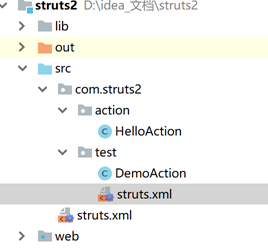Struts2基础入门
创建一个web工程

0)导包并且创建一个核心配置文件

<?xml version="1.0" encoding="UTF-8"?> <!DOCTYPE struts PUBLIC "-//Apache Software Foundation//DTD Struts Configuration 2.3//EN" "http://struts.apache.org/dtds/struts-2.3.dtd"> <struts> <!-- i18n:国际化. 解决post提交乱码 --> <constant name="struts.i18n.encoding" value="UTF-8"></constant> <!-- 指定访问action时的后缀名 http://localhost:8080/struts2_day01/hello/HelloAction.action http://localhost:8080/struts2_day01/hello/HelloAction.do --> <constant name="struts.action.extension" value="action,do"></constant> <!-- 指定struts2是否以开发模式运行 1.热加载主配置.(不需要重启即可生效) 2.提供更多错误信息输出,方便开发时的调试 --> <constant name="struts.devMode" value="true"></constant> <!-- package:将Action配置封装.就是可以在Package中配置很多action. name属性: 给包起个名字,起到标识作用.随便起.不能其他包名重复. namespace属性:给action的访问路径中定义一个命名空间 extends属性: 继承一个 指定包 abstract属性:包是否为抽象的; 标识性属性.标识该包不能独立运行.专门被继承 --> <package name="hello" namespace="/hello" extends="struts-default" > <!-- action元素:配置action类 name属性: 决定了Action访问资源名. class属性: action的完整类名 method属性: 指定调用Action中的哪个方法来处理请求 --> <action name="HelloAction" class="com.struts2.action.HelloAction" method="hello" > <!-- result元素:结果配置 name属性: 标识结果处理的名称.与action方法的返回值对应. type属性: 指定调用哪一个result类来处理结果,默认使用转发. 标签体:填写页面的相对路径 --> <result name="success" type="dispatcher" >/hello.jsp</result> </action> </package> <!-- 引入其他struts配置文件 --> <include file="com/struts2/test/struts.xml"></include> <!--<include file="cn/itheima/c_default/struts.xml"></include>--> </struts>

package com.struts2.action; /** * @author: 肖德子裕 * @date: 2018/11/19 22:15 * @description: */ public class HelloAction { public String hello(){ System.out.println("hello word"); return "success"; } }
1)测试动态方法调用方式

package com.struts2.test; /** * @author: 肖德子裕 * @date: 2018/11/20 8:58 * @description: */ public class DemoAction { public String add(){ System.out.println("添加用户!"); return "success"; } public String delete(){ System.out.println("删除用户!"); return "success"; } public String update(){ System.out.println("修改用户!"); return "success"; } public String find(){ System.out.println("查找用户!"); return "success"; } }

<?xml version="1.0" encoding="UTF-8"?> <!DOCTYPE struts PUBLIC "-//Apache Software Foundation//DTD Struts Configuration 2.3//EN" "http://struts.apache.org/dtds/struts-2.3.dtd"> <struts> <!-- 动态方法调用方式1:配置动态方法调用是否开启常量;默认是关闭的,需要开启;不建议使用 --> <!-- http://localhost:8080/demo/DemoAction!add.action --> <constant name="struts.enable.DynamicMethodInvocation" value="false"></constant> <package name="demo" namespace="/demo" extends="struts-default" > <!-- 动态方法调用方式2:通配符方式;使用{1}取出星号填充的内容;建议使用 --> <action name="DemoAction_*" class="com.struts2.test.DemoAction" method="{1}" > <result name="success" >/hello.jsp</result> </action> </package> </struts>
2)在web中配置拦截器
<?xml version="1.0" encoding="UTF-8"?> <web-app xmlns="http://xmlns.jcp.org/xml/ns/javaee" xmlns:xsi="http://www.w3.org/2001/XMLSchema-instance" xsi:schemaLocation="http://xmlns.jcp.org/xml/ns/javaee http://xmlns.jcp.org/xml/ns/javaee/web-app_4_0.xsd" version="4.0"> <!-- struts2核心过滤器 --> <filter> <filter-name>struts2</filter-name> <filter-class>org.apache.struts2.dispatcher.ng.filter.StrutsPrepareAndExecuteFilter</filter-class> </filter> <filter-mapping> <filter-name>struts2</filter-name> <url-pattern>/*</url-pattern> </filter-mapping> </web-app>
3)测试访问hello word
http://localhost:8080/hello/HelloAction.action
4)测试访问增删改查
http://localhost:8080/demo/DemoAction_add.action
